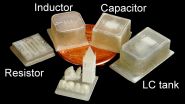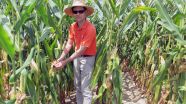(Press-News.org) Berkeley -- It might not be long before consumers can just hit "print" to create an electronic circuit or wireless sensor in the comfort of their homes.
Engineers at the University of California, Berkeley, in collaboration with colleagues at Taiwan's National Chiao Tung University, are expanding the already impressive portfolio of 3D printing technology to include electrical components, such as resistors, inductors, capacitors and integrated wireless electrical sensing systems. They have put the new technology to the test by printing a wireless "smart cap" for a milk carton that detected signs of spoilage using embedded sensors.
The findings are to be published Monday, July 20, in a new open-access journal in the Nature Publishing Group called Microsystems & Nanoengineering.
Major advances over the past 10 years have enabled the creation of a wide array of 3D-printed products, including prosthetics, medical implants, toys, vehicle parts, building materials and even food. What had been missing from the repertoire until now was the ability to produce sensitive electronic components.
"Our paper describes the first demonstration of 3D printing for working basic electrical components, as well as a working wireless sensor," said senior author Liwei Lin, a professor of mechanical engineering and co-director of the Berkeley Sensor and Actuator Center. "One day, people may simply download 3D-printing files from the Internet with customized shapes and colors and print out useful devices at home."
Polymers are attractive materials in the world of 3D printing because their flexibility allows them to be formed into a variety of shapes. However, such materials are poor conductors of electricity, and thus bad candidates for electronic devices. To get around this, the researchers started off by building a system using polymers and wax. They would then remove the wax, leaving hollow tubes into which liquid metal - in their experiments they used silver - was injected and then cured.
The shape and design of the metal determined the function of different electrical components. For instance, thin wires acted as resistors, and flat plates were made into capacitors. But the question remained: Do the pieces of metal actually do anything useful?
To answer that, the researchers integrated the electronic components into a plastic milk carton cap to monitor signs of spoilage. The "smart cap" was fitted with a capacitor and an inductor to form a resonant circuit. A quick flip of the carton allowed a bit of milk to get trapped in the cap's capacitor gap, and the entire carton was then left unopened at room temperature (about 71.6 degrees Fahrenheit) for 36 hours.
The circuit could detect the changes in electrical signals that accompany increased levels of bacteria. The researchers periodically monitored the changes with a wireless radio-frequency probe at the start of the experiment and every 12 hours thereafter, up to 36 hours. The property of milk changes gradually as it degrades, leading to variations in its electrical characteristics. Those changes were detected wirelessly using the smart cap, which found that the peak vibration frequency of the room-temperature milk dropped by 4.3 percent after 36 hours. In comparison, a carton of milk kept in refrigeration at 39.2 degrees Fahrenheit saw a relatively minor 0.12 percent shift in frequency over the same time period.
"This 3D-printing technology could eventually make electronic circuits cheap enough to be added to packaging to provide food safety alerts for consumers," said Lin. "You could imagine a scenario where you can use your cellphone to check the freshness of food while it's still on the store shelves."
As 3D printers become cheaper and better, the options for electronics will expand, said Lin, though he does not think people will be printing out their own smartphones or computers anytime soon.
"That would be very difficult because of the extremely small size of modern electronics," he said. "It might also not be practical in terms of price since current integrated circuits are made by batch fabrication to keep costs low. Instead, I see 3D-printed microelectronic devices as very promising for systems that would benefit from customization."
Lin said his lab is working on developing this technology for health applications, such as implantable devices with embedded transducers that can monitor blood pressure, muscle strain and drug concentrations.
INFORMATION:
The co-lead authors of the study are UC Berkeley research specialist Chen Yang and visiting Ph.D. student Sung-Yueh Wu, both working in Lin's lab. Wu is also a student of study co-author Wensyang Hsu, a professor of mechanical engineering at National Chiao Tung University.
Anyone who's ever noticed a water puddle drying in the sun has seen an environment that may have driven the type of chemical reactions that scientists believe were critical to the formation of life on the early Earth.
Research reported July 15 in the journal Angewandte Chemie International Edition demonstrates that important molecules of contemporary life, known as polypeptides, can be formed simply by mixing amino and hydroxy acids - which are believed to have existed together on the early Earth - then subjecting them to cycles of wet and dry conditions. This simple ...
The first worldwide study of animals and the seeds they eat has overturned a long-held assumption - that large animals mainly eat large seeds.
The finding by UNSW Australia scientists has implications for conservation showing that a wider variety of plants than is often thought could be at risk if large animals go extinct and do not disperse their seeds.
In a comprehensive study, UNSW's Si-Chong Chen and Professor Angela Moles compiled and analysed data on more than 13,000 animal-seed interactions, based on previously published reports.
"It is the first broad-scale study ...
Scientists studying thin layers of phosphorus have found surprising properties that could open the door to ultrathin and ultralight solar cells and LEDs.
The team used sticky tape to create single-atom thick layers, termed phosphorene, in the same simple way as the Nobel-prize winning discovery of graphene.
Unlike graphene, phosphorene is a semiconductor, like silicon, which is the basis of current electronics technology.
"Because phosphorene is so thin and light, it creates possibilities for making lots of interesting devices, such as LEDs or solar cells," said lead ...
The manipulation of light has led to many applications that have revolutionized society through communications, medicine and entertainment. Devices consuming the energy of electromagnetic radiation, such as absorbers and sensors, play an essential role in the using and controlling of light.
The researchers at the Aalto University Department of Radio Science and Engineering have demonstrated the first realization of absorbers that do not reflect light over a wide range of frequencies. All previous absorbers at other frequencies were either fully reflective, as mirrors, ...
Marine species that already have large ranges are extending their territories fastest in response to climate change, according to new research from University of British Columbia biodiversity experts.
The study is one of the first comprehensive looks at how traits--other than thermal niche--impact marine animals' ability to respond to climate change. It could help improve global predictions of how different species redistribute as the oceans warm, and identify species in greatest jeopardy.
"We have a bit of a mystery as to why some animals are moving quickly into cooler ...
Wood and its response to stress or strain has been less known at a fundamental level - until now.
The structural properties of brittle materials like rock or ceramic, such as cracking under stress, have long been studied in detail, providing insight into avalanches, earthquakes and landslides. Wood and its response to stress or strain has been less known at a fundamental level - until now.
Scientists, from the Department of Applied Physics at Aalto University in Finland, have applied well-established methods for studying all kinds of materials to wood, namely through ...
Philadelphia, PA, July 20, 2015 - Exposure therapy is a commonly used and effective treatment for anxiety disorders, including posttraumatic stress disorder, obsessive-compulsive disorder, and phobias.
The goal of such therapy is to extinguish fear, which is accomplished by presenting cues that are known to predict a negative experience in the absence of that experience. Over time, learning that the 'danger cue' is no longer dangerous produces extinction of the fearful response.
However, fears and the associated defensive behaviors resulting from that fear often return ...
FLORENCE - There are almost 275,000 acres of corn planted in South Carolina, with an economic impact of approximately $130 million. Though this is dwarfed by Midwest states such as Iowa (13.7 million acres, $8.75 billion), it's still a lot of corn - enough, at least, to make a person think S.C. would be a utopia for the insects that like to feast on tasty yellow kernels.
But instead of being a slice of paradise, a cornfield can often be a far-from-optimal host for pests such as the corn earworm. Francis Reay-Jones, an associate professor and research scientist for Clemson ...
A new study from The University of Texas Health Science Center at San Antonio found that mothers with chemical intolerances are two to three times more likely than other women to have a child with autism spectrum disorder (ASD) or attention deficit hyperactivity disorder (ADHD).
The medical study was published in the July-August 2015 issue of the Journal of the American Board of Family Medicine.
People who are chemically intolerant often have serious reactions to common chemicals and some become too sick to carry out routine functions. Chemical intolerance affects about ...
New research reveals that the more people think they know about a topic in general, the more likely they are to allege knowledge of completely made-up information and false facts, a phenomenon known as "overclaiming." The findings are published in Psychological Science, a journal of the Association for Psychological Science.
"Our work suggests that the seemingly straightforward task of judging one's knowledge may not be so simple, particularly for individuals who believe they have a relatively high level of knowledge to begin with," says psychological scientist Stav Atir ...







